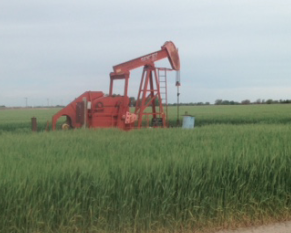By JOHN P. TRETBAR
Kansas Common crude at CHS in McPherson starts the week at $45 per barrel after gaining 25 cents a barrel on Friday. Cash crude on the Nymex closed at $54.82 per barrel Friday.
Independent Oil & Gas Service reports a ten percent increase in the weekly Kansas rig count. There are nine active rigs in the eastern half of the state, down two for the week, and 25 west of Wichita, an increase of five rigs. Operators are about to spud new wells on two leases in Barton County, one in Ellis County and one in Russell County.
Baker Hughes reported 935 active rotary rigs for the week nationwide. An increase of six oil rigs was offset by declines in horizontal, gas and miscellaneous rigs. Texas and West Virginia were down four rigs each. Oklahoma was down one.
Independent Oil & Gas Service reported 55 newly-completed wells across the state last week, 28 in eastern Kansas and 27 west of Wichita. Operators have completed 924 wells statewide so far this year. There were two new completions in Barton County and one in Ellis County. All three were dry holes.
Regulators authorized 22 permits for drilling at new locations across Kansas last week, eight east of Wichita and 14 in Western Kansas and 608 so far this year. There’s one new permit on file in Ellis County.
The U.S. Energy Information Administration said domestic crude inventories increased by 1.6 million barrels. Stockpiles are now about three percent above the five-year season average at 440.5 million [[“440 point five million”]] barrels.
The government reported the second-best weekly production total ever. For the week ending August 9, U.S. producers pumped 12,333,000 barrels per day of crude oil. That’s an increase of 80,000 barrels per day over the week before and just 45,000 barrels per day shy of the record set during the last week in May.
Once among the largest landholders in western Canada’s oil sands region, Wichita-based Koch Industries has sold off leases and abandoned licenses there. The Kansas company joins a stream of foreign companies exiting the formation, according to reporting by the Financial Post. Koch struck an agreement to sell its land in the region to Calgary-based Cavalier Energy, in a transaction that occurred in June.
Regulators in Texas reported a significant drop in crude oil and condensate production for the month of May. According to the Railroad Commission of Texas, May production totaled over 116 million barrels, which is down 9.5 million barrels from the month before and down 13.5 million barrels from May of last year.
Operators in North Dakota, the number-two oil producing state in the country, pumped a new all-time record in June, 1.42 million barrels per day. The state’s Department of Mineral Resources reports North Dakota also set a record for the most producing wells, at 15,741.
Western Kingfisher County Oklahoma continued to shake nearly two weeks after an oil and gas operator stopped trying to complete wells at one of its locations. According to the Daily Oklahoman, an ongoing swarm of earthquakes impacted an area about 8 miles west of the county seat. Dozens of seismic events were observed in the general area since completion efforts ended July 24. The events have varied in strength, from as little as one on the Richter scale to as large as a 3.5 magnitude event observed a week ago. The swarm included a 3.6-magnitude event that is believed to be the largest temblor ever associated with hydraulic fracturing.
A County Assessor in Oklahoma is going to court to collect an additional $273 million in property taxes from seven energy producers. The court cases stem from crude stored in tank farms at Cushing. The companies are claiming a tax break under what’s called the “Freeport exemption,” which protects crude oil from state property taxes if it’s just passing through Oklahoma as interstate commerce. The county is asserting the crude in question was bought and sold in Oklahoma, according to the Stillwater News Press.

